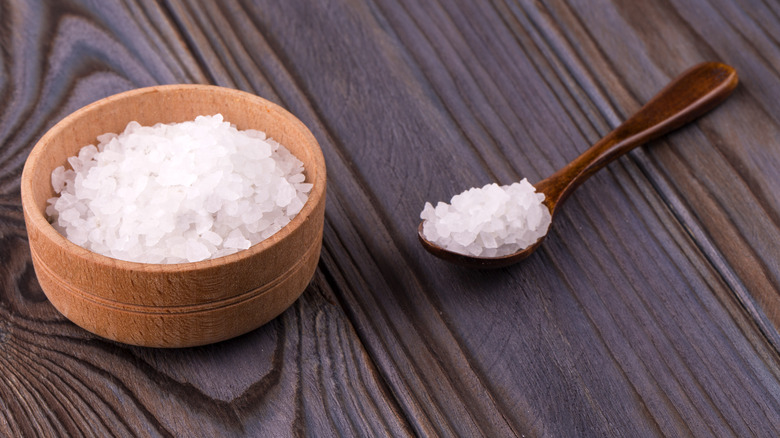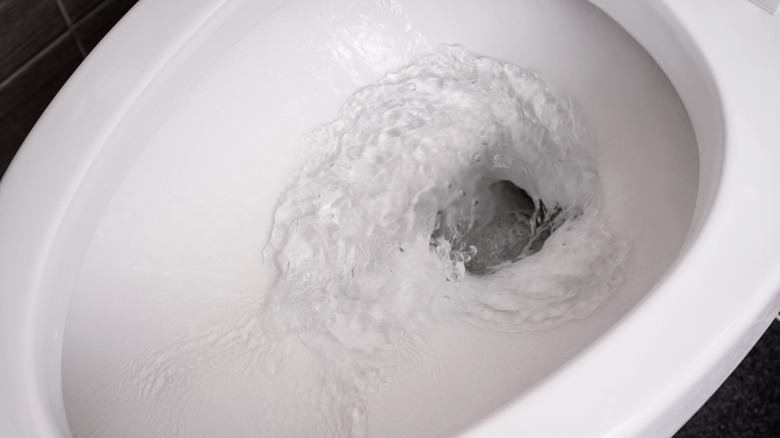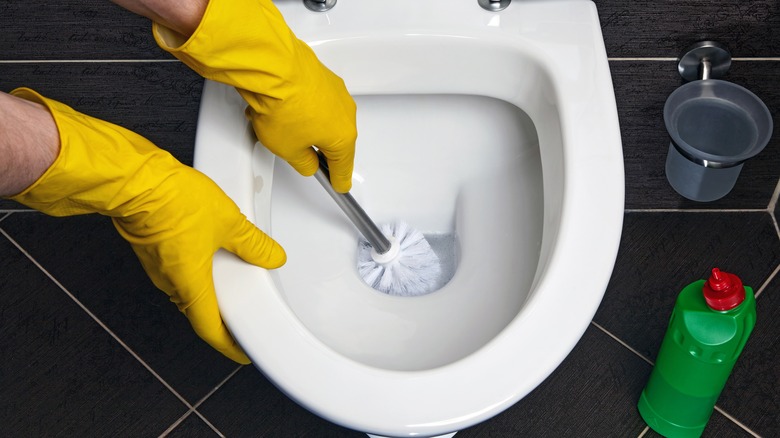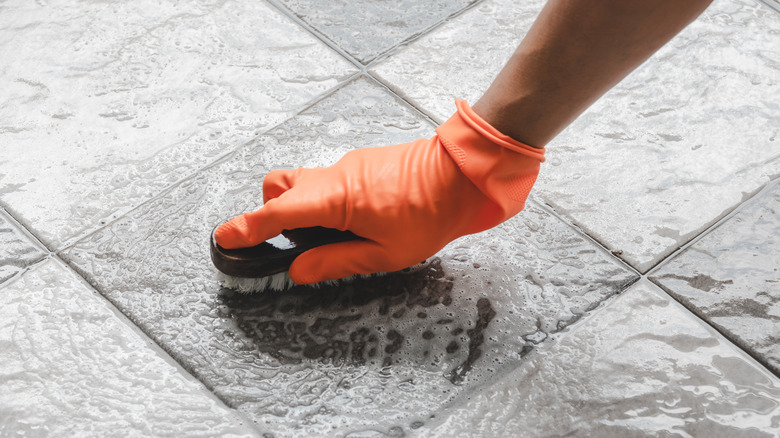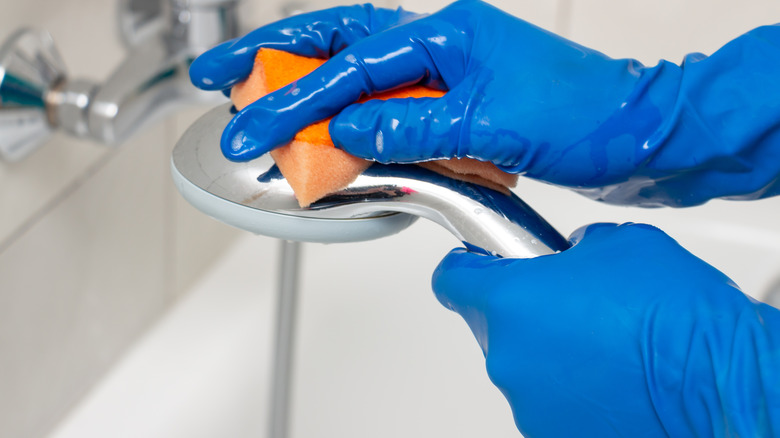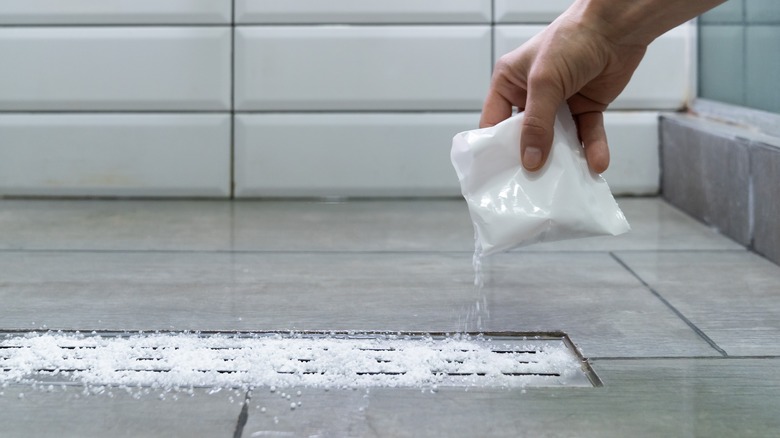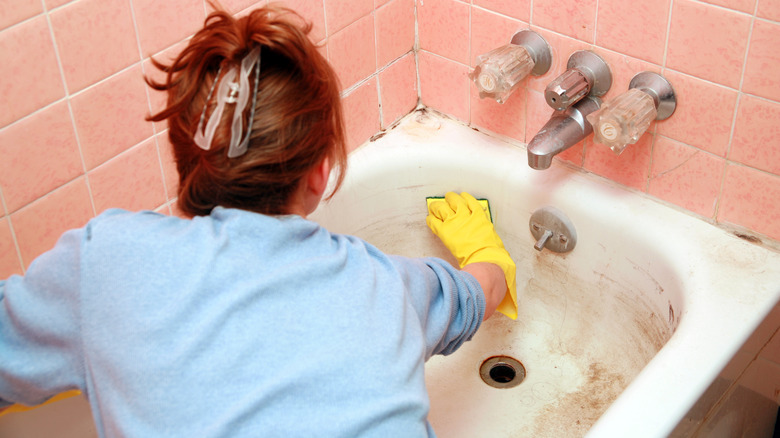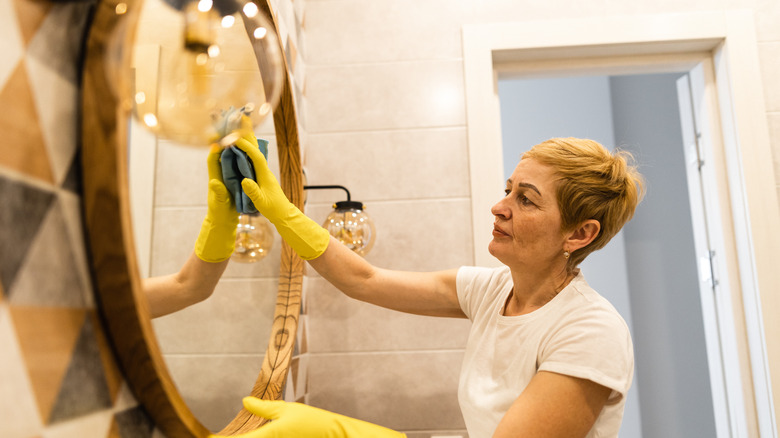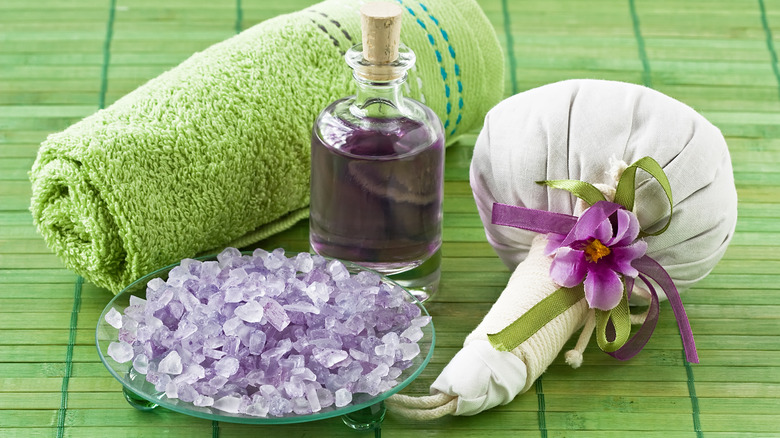8 Smart Ways To Incorporate Epsom Salt Into Your Bathroom Cleaning Routine
There's nothing quite like taking a hot bath to unwind after a long day. For those of us who find soaking in a tub the most relaxing way to decompress, Epsom salt is a must-have product. Relaxing as it is, you may not realize how many ways you can use this stress-relieving bath necessity to clean your entire bathroom. Unlike table salt, Epsom salt is magnesium-based rather than sodium-based, giving it extra cleaning power when trying to eliminate issues like removing soap scum.
Aside from its unique ingredients, Epsom salt offers extra scrubbing power when loosening stubborn areas. Keep in mind that it will dissolve within a few minutes when added to hot water, so, for some areas, it's best to use it a bit at a time if you need the coarseness to break through tough build-up. However, each area of the room requires differing techniques, so let's dive into the smart ways to incorporate Epsom salt into your bathroom cleaning routine.
Unclog your toilet
Dealing with a clogged toilet isn't an enjoyable task, but unfortunately, it needs tackling as soon as it occurs. However, you likely have an unclogging tool sitting in a cabinet or on the edge of your tub: Epsom salt. This typical bathroom product usually fizzes up, which helps to loosen whatever is keeping the water from draining. Nearly any type of salt will work, though Epsom salt tends to work the quickest. For an overnight table salt solution, use a mixture of a cup of table salt, a cup of baking soda, and 12 cups of hot water.
Pour about a cup of Epsom salt into the toilet bowl. If you don't have any Epsom salt, most bath bombs will have the same effect. As the magnesium sulfate reacts with the water, you should notice some bubbling and maybe even a soft buzzing noise. Allow it to sit and do its job for about 20 minutes, which should be enough time to break up the blockage. Flush with hot water to help dissolve the Epsom salt, but avoid using boiling water, as it could crack the porcelain.
Mix a DIY toilet cleaner
Not only can Epsom salt clear a clogged toilet, but you can also use it to make a reliable DIY toilet cleaner. Whether you have run out of your usual solvent or want to switch to more natural products, this effective cleaning solution is worth trying. It's an inexpensive option, and you likely already have the necessary ingredients to create it. Even if you're a little behind on your toilet cleaning regimen, the Epsom salt can cut through unyielding hard water stains living on the porcelain.
To make this solution, add one cup of Epsom salt and two tablespoons of your favorite dish soap to three cups of distilled white vinegar. Add a couple of drops of lemon essential oil for extra disinfecting power and a fresh citrus scent. While more research is required, one study published in Frontiers of Public Health showed that essential oils effectively reduced viral and bacterial microorganisms. Once you've mixed all the ingredients, pour them into the toilet bowl, allowing them to sit and soak into the stains for five to 10 minutes. Then, scrub with a toilet brush as usual to eliminate any staining.
Make your grout and tile look like new
While grout and tile are often overlooked in our regular deep cleans, eliminating the stains can make your bathroom look brand new again. One reason it's such a daunting task is the porous grout grabs onto any hint of dirt that comes near it. Epsom salt works well as a tile and grout cleaner because it adds some coarseness to help scrub away discoloration. While this product helps remove limestone and hard water stains, it isn't alkaline or acidic enough to "eat" through them. It is, however, small and abrasive enough to get into those hard-to-reach places, making the cleaning process a bit easier.
To make a natural tile and grout cleaner, mix an equal ratio of vinegar and water in a bucket. Keep the Epsom salt in a separate pan or tub. Dip your sponge into the bucket to absorb the diluted vinegar and squeeze out some of the excess before pressing the same sponge into the container with the salt, ensuring you have a good layer stuck to it. Start scrubbing the grout until you notice the stains lifting. This works in two steps. First, the abrasiveness of the Epsom salt will start breaking up the dirt before it dissolves. Then, the acidic vinegar will begin eating away whatever is remaining. After the Epsom salt disintegrates, you can work on cleaning the surrounding tile. Rinse and wipe up any remaining solution.
Descale your showerhead
Although hard water poses no health risks, it can cause issues for your showerhead. Not only is it unpleasant to look at, but the mineral buildup can begin to clog the small holes where water flows out over time. If you don't regularly descale it, you may have a noticeable decrease in water pressure, and some of the tiny pathways may even get blocked off. Epsom salt softens the water, breaking up the stains and buildup left behind.
You'll need some basic ingredients for this method: one cup of Epsom salt, half a cup of baking soda, and a quarter cup of your chosen dish soap. Mix everything and cover the entirety of your showerhead. Use a small scrub brush or an old toothbrush to scour away the buildup and staining. Once you eliminate the soap scum, use a damp rag to wipe it clean. To help prevent future buildup, wipe down your showerhead with a towel to keep the water from sitting on the surface.
Clean out your drains
Clogged and smelly drains are some of the grossest things that can happen in the household. Most of us don't even think about our drains until they aren't draining anymore. However, keeping up with cleaning your drains can prevent clogs by helping dirt move through before it ultimately builds up. Luckily, Epsom salt is handy in both situations; you can use it to maintain cleanliness or if you're already dealing with a blockage. Chemicals may work well, though some believe the harsh ingredients can cause more damage than good to your pipes.
First, check the salt packaging to ensure it's fully dissolvable. You should only use products that will fully break down; otherwise, you'll only worsen drainage problems. Pour hot water down your drain to loosen up the junk, then sprinkle in a couple of tablespoons of Epsom salt, followed by more hot water. This method both cleans and unclogs drains, though you'll have to repeat the steps a few times to work through more robust blockages. It's important to note that this mixture works best to clear out partial clogs. So, if you still have standing water after a couple of attempts, it may be best to contact a professional.
Eliminate hard water stains on sink and tub
Hard water stains don't just affect the showerhead; they muck up any area of your bathroom where water regularly flows. These whitish discolorations sitting on your faucets and around your tub come from the minerals in your water. When using your sink and tub, water will inevitably cover a lot of surface area, leaving tiny drops to sit until they evaporate. Once evaporated, all that's left are the minerals, which build up over time, creating noticeable spots. Epsom salt is just the thing to freshen up your bathroom.
Mix one cup of Epsom salt, one cup of vinegar, and a small amount of dish soap (just a quick squeeze), and blend the ingredients together until you have a thick paste. Cover any areas containing mildew or hard water stains entirely and leave to soak for 10 to 15 minutes. Once the time is up, use a sponge or scrub brush to work the solution into the area until it's clean. You can also dilute this mixture with a cup or two of warm water to create a cleaning product that removes the rest of the dirt or grime from your tub and sink. You don't need to let the watered-down version sit; simply dip the sponge or rag into the mixture and scrub your sinks and tub from top to bottom. Rinse with water, and make sure to dry any wet areas completely once you're finished.
Shine your bathroom mirrors
One of the reasons Epsom salt makes such an effective cleaner is its coarseness, allowing it to scrub areas with tough grime deeply. However, is this gritty mineral too abrasive to use on a glass mirror? It won't scratch glass when used correctly, but you'll want to avoid using it too harshly. While no scientific studies have been done on this subject, many experts agree (as detailed on Glass Helper) that Epsom salt is an excellent natural ingredient for cleaning glass and mirrors.
Combine equal parts Epsom salt and baking soda with enough dish soap to form a thick paste. Use a clean, wet rag to pick up a small amount of the mixture before gently rubbing in circular motions on the glass. Don't press hard; the ingredients will do most of the work to break through the toothpaste droplets and soap scum. Use a microfiber rag or a paper towel to wipe off the bulk of the paste. Redampen the cloth and go over the glass again, leaving the dissolved Epsom salt solution to sit on the surface for 10 to 15 minutes. Do a quick once over with your cloth to remove any remaining stains, rinse with warm water, and dry with a fresh, soft cloth or paper towel.
Remove odors by creating scent bags
The bathroom is hardly the most popular area of the home to tackle, as the messiness, germs, and smells are undoubtedly a lot to take care of. At the end of your bathroom cleaning routine, consider creating some scent bags or jars to keep the room filled with your favorite fragrance. You can use small mesh bags, jewelry bags, or glass jars to hold the ingredients and fight against odors of all kinds.
In a bowl, add a two-to-one ratio of rice and Epsom salt. Add 10 to 20 drops of your favorite essential oils, and mix it all together. Lemon is a common scent for bathrooms because it has a fresh, clean fragrance, and for a more relaxing feel, lavender may be the way to go. However, the essential oil you choose is entirely up to you, and you can even combine a few to make the perfect aroma for your tastes. Then, you can divide the mixture into small baggies or jars to place around your bathroom. For an aesthetic touch, sprinkle in a few pieces of your favorite dried flower petals.
